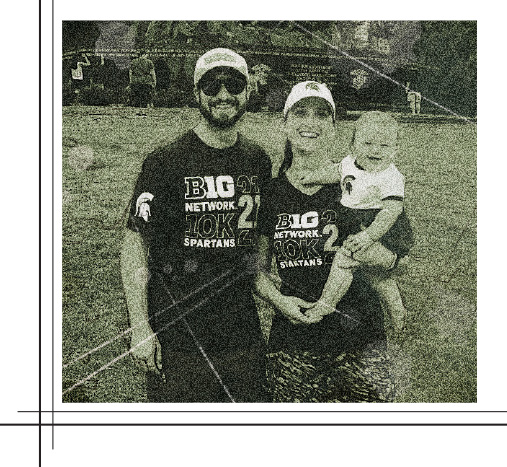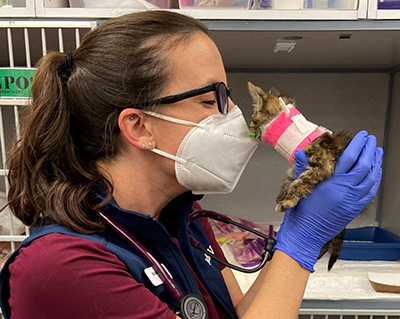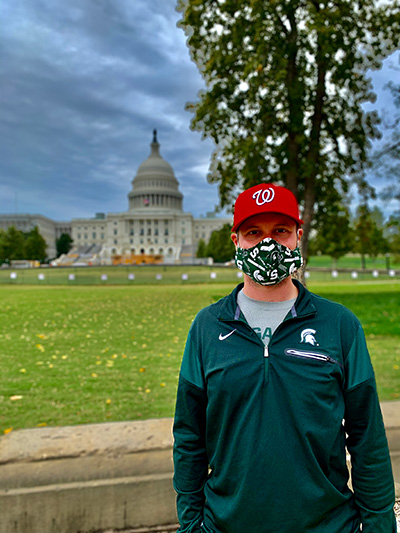
The Perfect Match: Controlled Chaos and Laser Cows
Michelle - DVM Class of 2017
Matt - DVM Class of 2018; PhD 2020

Michelle - DVM Class of 2017
Matt - DVM Class of 2018; PhD 2020
My husband Matt and I met in vet school as the president and vice-president of our class. But our shared education is about the only similarity between our careers. I jumped head-first into emergency medicine the week after graduating. I love the controlled chaos that can accompany a new and unexpected case coming through the doors. Within a year, I was promoted to the position of medical director at my hospital, so I harkened back to my previous graduate education in management to tackle a challenge that, at times, pushed me to my limit.

Matt, on the other hand, is the yin to my yang. In school, he focused on food animals and found a passion in science policy. (He never grasped my love of the feline kind.) He started a PhD during vet school that kept him busy for the immediate years after graduation as well. Matt’s desire to pursue a career in science policy ultimately led him to his first role after graduate school with the US Department of Defense as an American Association for the Advancement of Science (AAAS) Science and Technology Policy Fellow—just about as far from the clinic as a veterinarian can get.
Matt’s fellowship moved us to the East Coast, where I became a relief veterinarian for several local emergency hospitals, in addition to now being a working mom. Learning to conform to the policies and nuances of different hospitals each week was an adjustment, but ultimately, good medicine is the same wherever you practice.
One downside of being a relief veterinarian is that I no longer get to perform surgeries. Nonetheless, I feel fortunate to be able to continue to practice emergency medicine after our move. I have come to love the unknowns of this field and the opportunity to, in many cases, turn around one of the worst days in a pet owner’s life.
Having moved during the middle of the COVID-19 pandemic, Matt’s workplace experience out of school has been much different from mine. As a subject-matter expert for a peer-reviewed journal published by the Department of Defense, Matt mostly worked from home for the duration of this assignment, and rarely saw animal health-related research in a normal workday. Rather, he applied the scientific concepts he learned during his PhD research to other fields, typically those in the physical sciences, such as wing aerodynamics or explosive energetics. With primarily editing responsibilities, Matt found great satisfaction in helping authors engage readers more effectively to increase their research’s impact.

Although this position was endlessly educational, Matt moved to the Department of Homeland Security (DHS) earlier this fall for the second year of his fellowship to get closer to his true expertise. I joke that I have never really understood what Matt does in his roles with the federal government, but he tells me at DHS, he works with a team on bolstering the bio- and agro-defenses of our country (which I assume means cows with lasers beams attached to their heads). Here, he truly relies on his veterinary training and animal science background to inform and implement federal policies surrounding foreign animal and crop diseases that threaten our food security.
One thing Matt and I do have in common is our desire to give back to the veterinary community. As a recent graduate, I was fortunate to be involved in the MSU College of Veterinary Medicine’s curriculum reinvention, for which I brought the perspective of an early-career emergency veterinarian to the group. Working for multiple hospitals—and thus, working with several recent graduates—I am continuously reminded of the differences in education students receive and the need for voices from all aspects of medicine to drive learning.

I have always taken a practical approach to medicine, one that emphasizes treating the animal, rather than the condition. In step with this approach, I sincerely focus on effective client communication, the need for which I came to understand as a medical director. I find that these areas of emphasis are difficult to formally teach to students. In the future, I hope to use my breadth of experience to help train veterinary students.
During school, Matt sat on the Michigan Veterinary Medical Association’s legislative advisory committee, and attended several congressional fly-in events for various veterinary and livestock groups. With a focus on science policy, he set his sights on the laws and regulations that impact the practice of veterinary medicine, rather than the medicine itself. These experiences bolstered his desire to pursue a career in science policy and advocate for increasing the presence of science to inform federal, state, and local decision making.Although he does not practice, Matt is very proud of the way his work, inside and outside of his career, broadly impacts animals and public health.
As we look to bring our experiences and passion for animal health back to the Mitten State in the next few years, Matt and I are both excited for the unknowns that this transition will bring. As our family grows, we are adjusting to a new work-life balance, and know this adjustment will be continual for the foreseeable future.
We’ve each had first-hand experiences in pushing the limits of our educational training, and we hope students pursuing veterinary medicine, or veterinarians looking for a change, can learn from our experiences; the opportunities are endless where there is an interest to learn, willingness to be (temporarily) uncomfortable, and a drive to succeed.